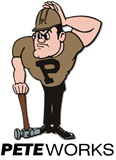|
|
3D
Printing in ARMS 2098
The printers in ARMS 2098 are primarily for the use in AAE
Design/Build courses.
All printer use requests must come through Tom Bietsch (tbietsch@purdue.edu). Please have
.stl files prepared.
Best Practices for these printers are as follows:
- Export a good quality STL file. In Catia, this is done by
changing 2D and 3D Accuracy:
- Open Tools → Options → General → Display
- Select the "Fixed:" radio button and reduce the input to
0.01
- Export using File → Save As → *.stl
- Set up Repetier Host - this
will be used for slicing
- Download and install for your OS
- Download Repetier Host
settings
- Manually copy the settings seen in the screenshots -
there is no automated import option
- Download Cura
profiles, unzip to your desired directory, then
- In Repetier Host, click on Slicer tab
- Select CuraEngine from Slicer: dropdown menu
- Click on Configuration button
- Click on Import → Select the desired .rcp files to
import
- Select Save, then Close
- Download Slic3r
profiles, unzip to your desired directory, and then
- In Repetier Host, click on Slicer tab
- Select Slic3r from Slicer: dropdown menu
- Click on Configuration button - this will open Slic3r
as a new program
- Click on File → Load Config Bundle and select the .ini
file to import
- Print Settings, Filament, and Printer should populate
- Open your STL in Repetier Host. Adjust if needed.
- If scale seems off, you may try deleting and changing:
Config → Units of imported Objects, then readding your part
- Rotate or position part as desired. Be conscious of plate
contact and possible supports needed
- Click on the Slicer tab. Slice your STL with using
the following settings:
- For Wings, use Slic3r. Depending on the size of the wing,
this may take a few minutes to an hour (more for bigger wings)
- For non-wing prints, use Cura. This should be fairly
quick for most models
- Use a 0.4mm nozzle if at all possible. Other size nozzles
are available, but a good case must be made for their use.
- Adhesion Type, Support Type, Quality, Infill, and Speed
are all subject to change depending on the model. "Normal" values are:
- Adhesion Type: None (for large enough prints to stick
on their own)
- Quality: 0.2mm is good and usually fast enough; 0.1mm
is very fine but takes twice as long
- Support Type: None for parts with no overhangs
(cantilevers) or holes
- Speed: 50mm/s nominal
- Infill Density: 20% or more for structural parts; 1% or
2% for wings
- Click ►Slice
- Inspect the output for filament used and expected time to
print.
- Here is an Excel file to
estimate print weight given length of extrusion. Keep in mind this
includes ALL filament, including support.
- Send your original stl file to Phil along with the settings
you would like to use.
- Upon verification of STL, settings, and validated slicing,
your print will be added to the queue.
- You will receive an email once printing is started, along
with an estimated time to completion.
For more reading on Delta-style 3D Printers:
| Printer 1 Live View |
Printer 2 Live View |

|

|
|



